Abstract
Recent reports of the transmission of human immunodeficiency virus (HIV) in health care settings have caused considerable public health concern. HIV as well as hepatitis B virus (HBV) and other bloodborne pathogens do constitute infectious hazards in certain settings. Transmission has been reported from patient to patient, patient to health care workers, and rarely, from health care worker to patient. Although the risk of bloodborne pathogen transmission is largely preventable, it may occur due to the use of infected blood for transfusion, the use of improperly sterilized medical or dental equipment, and accidental punctures with contaminated instruments. The risk of transmission of bloodborne pathogens is dependent on a number of factors and appears to be greater for HBV than for HIV. General guidelines for the prevention of transmission in health care settings are given, including the concept of "universal precautions", the need for adequate supplies of sterile equipment, the reduction of unnecessary injections and transfusions, and the appropriate use of hepatitis B vaccine. In addition, areas for research are highlighted that could improve understanding of transmission risks in different health situations and provide the information necessary to develop more effective measures to protect both care providers and patients.
Full text
PDF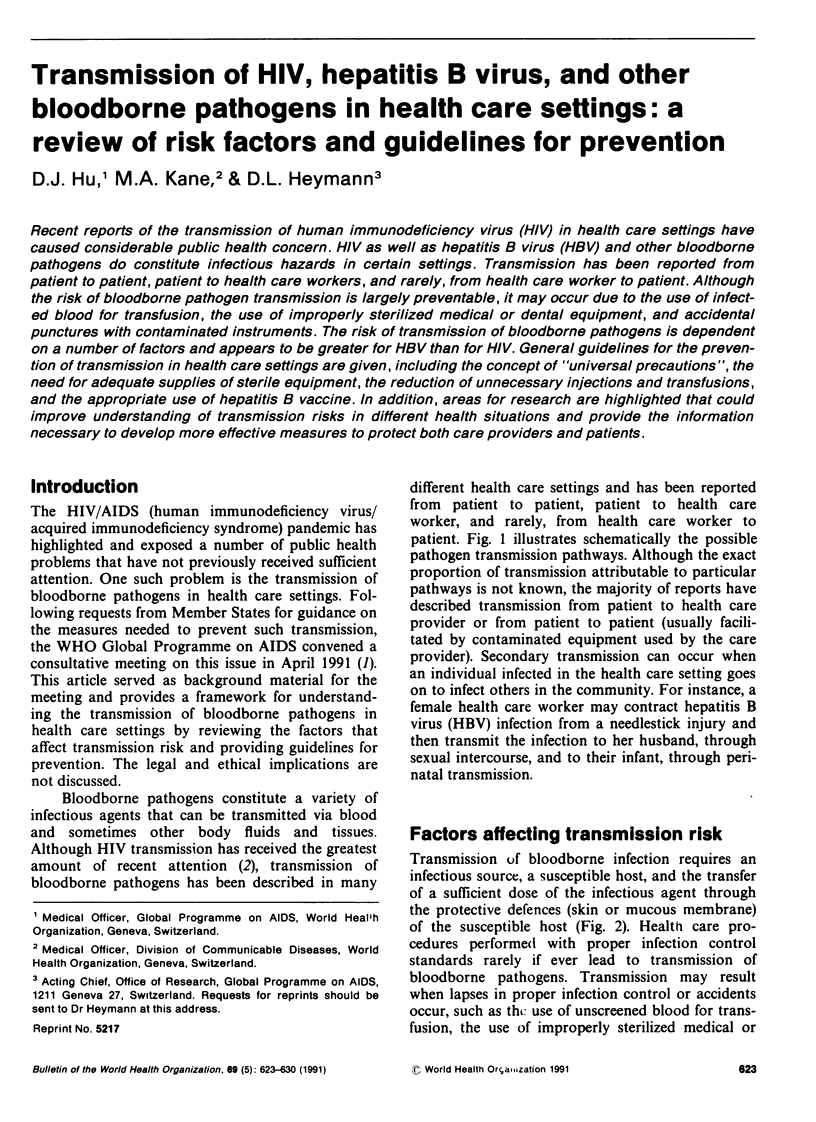
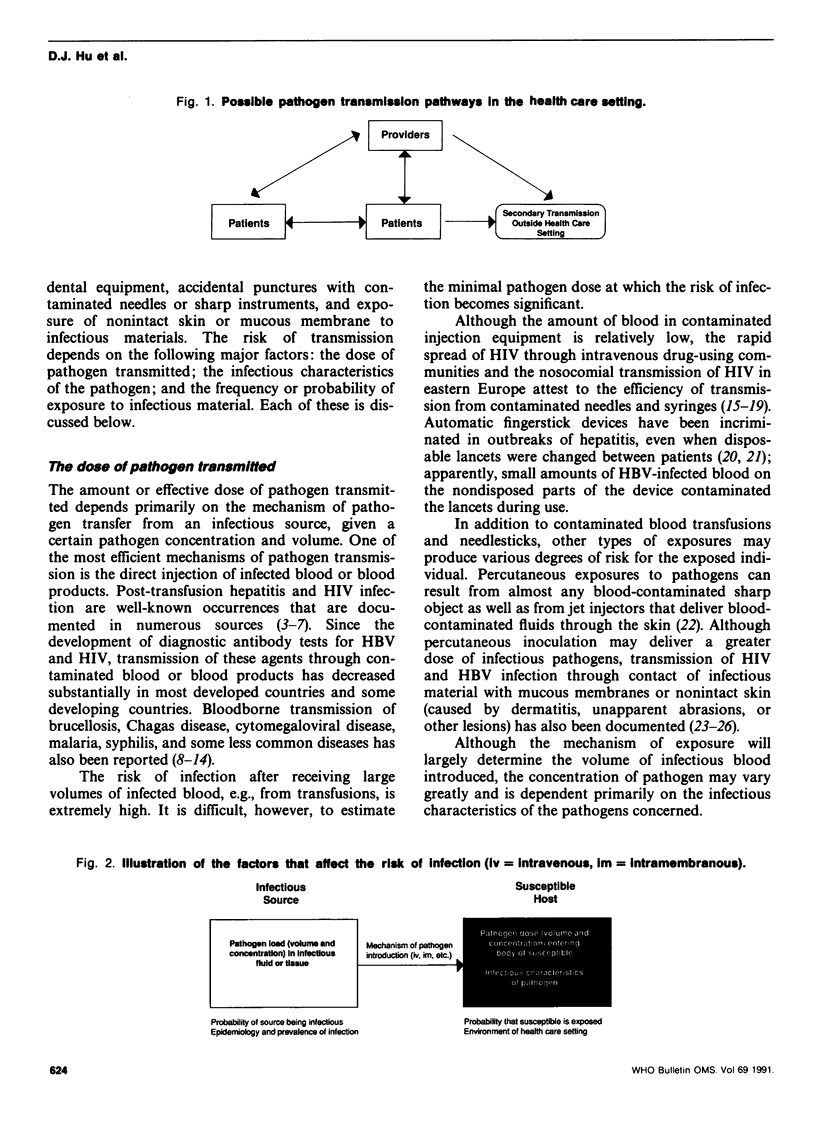

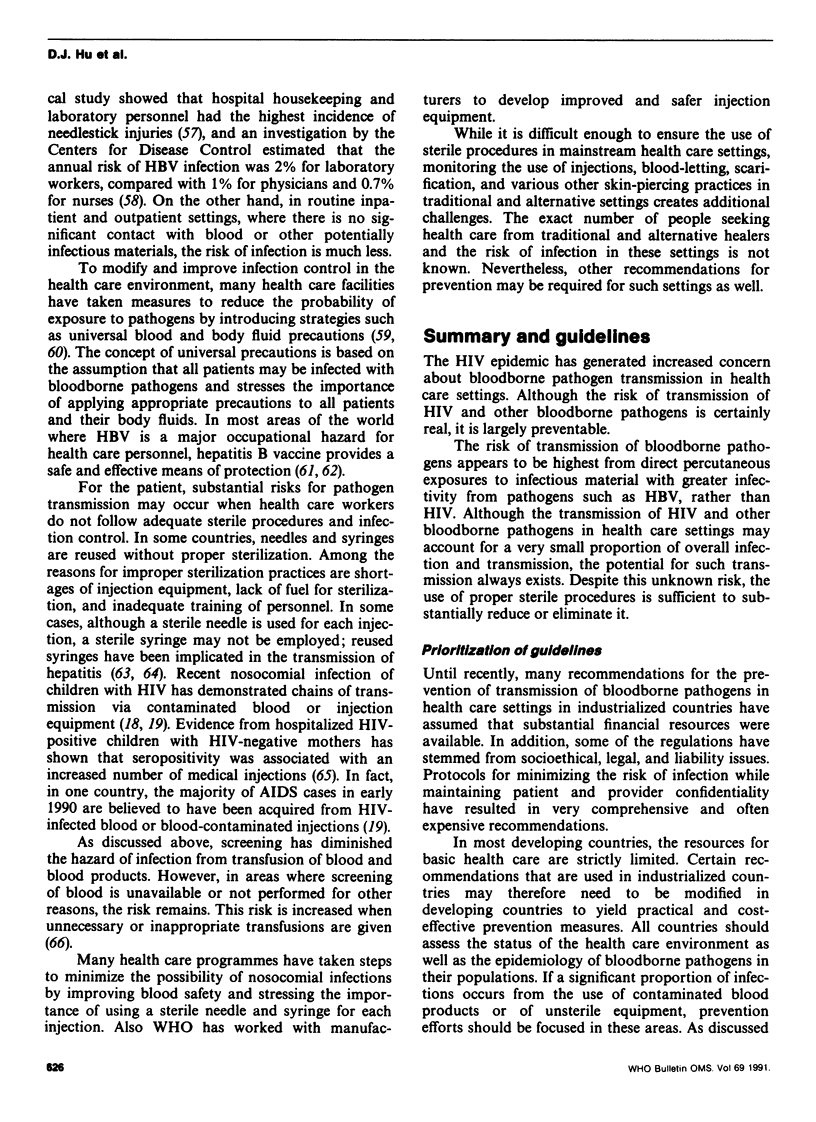
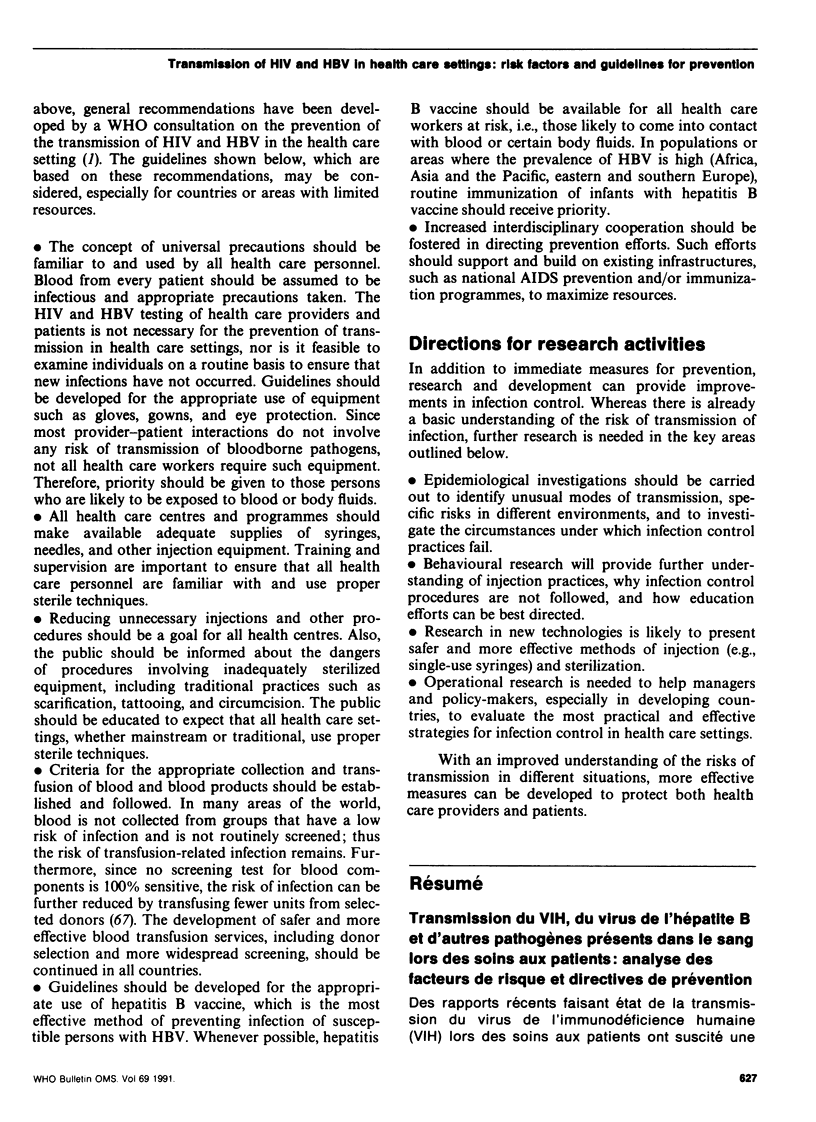

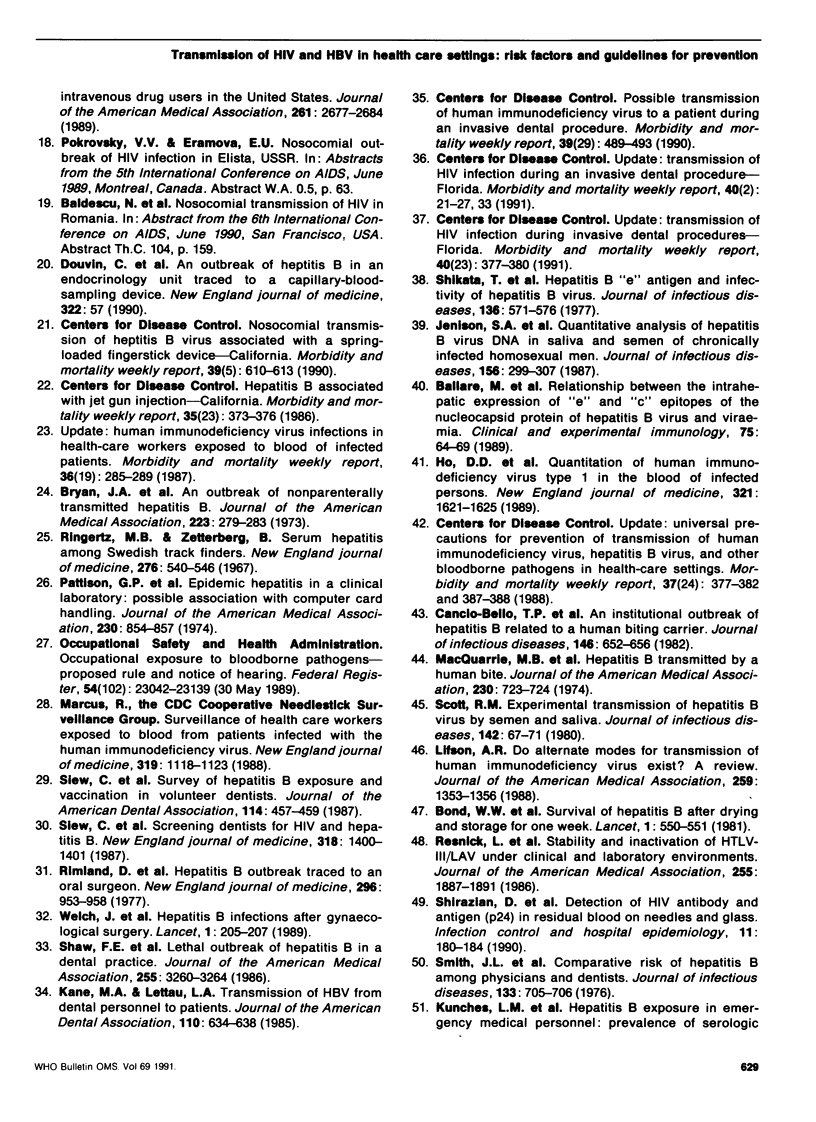
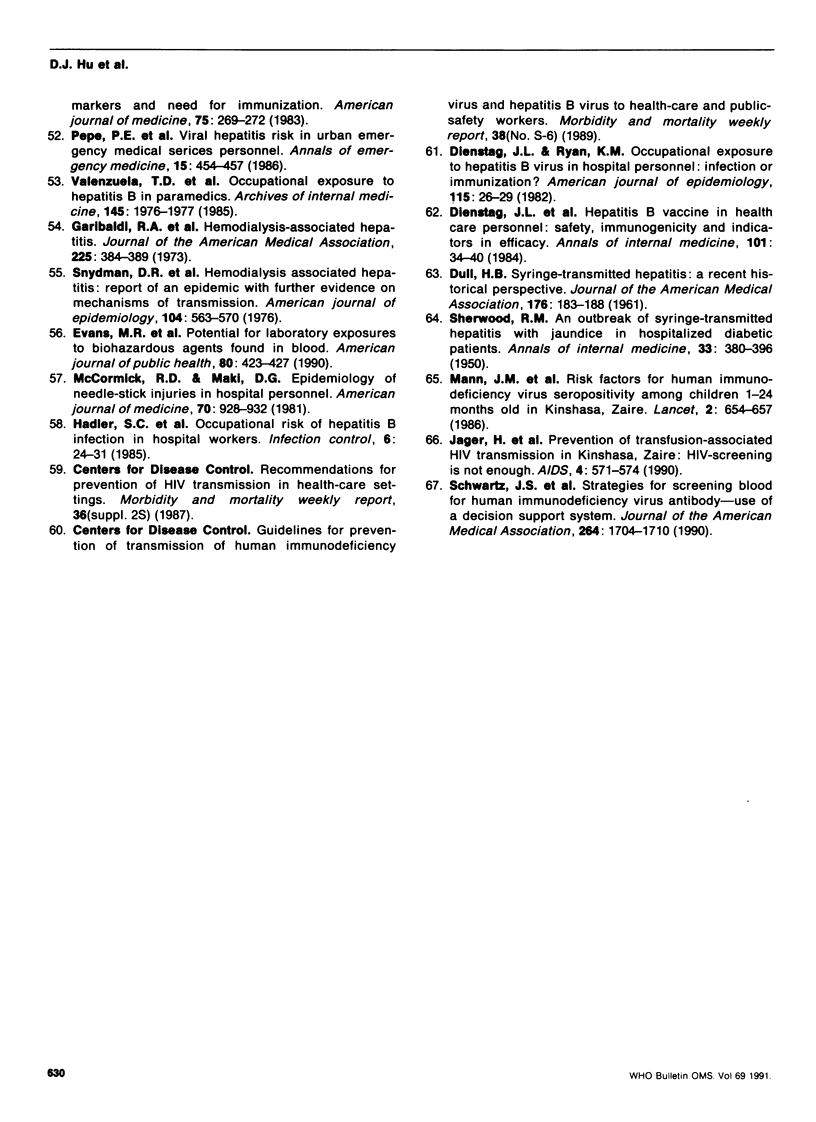
Selected References
These references are in PubMed. This may not be the complete list of references from this article.
- Adler S. P. Transfusion-associated cytomegalovirus infections. Rev Infect Dis. 1983 Nov-Dec;5(6):977–993. doi: 10.1093/clinids/5.6.977. [DOI] [PubMed] [Google Scholar]
- Alter H. J., Holland P. V., Purcell R. H. The emerging pattern of post-transfusion hepatitis. Am J Med Sci. 1975 Sep-Oct;270(2):329–334. doi: 10.1097/00000441-197509000-00014. [DOI] [PubMed] [Google Scholar]
- Angarano G., Pastore G., Monno L., Santantonio T., Luchena N., Schiraldi O. Rapid spread of HTLV-III infection among drug addicts in Italy. Lancet. 1985 Dec 7;2(8467):1302–1302. doi: 10.1016/s0140-6736(85)91581-8. [DOI] [PubMed] [Google Scholar]
- Ballaré M., Lavarini C., Brunetto M. R., Petruzzelli E., Dovis M., Molino G., Bonino F. Relationship between the intrahepatic expression of 'e' and 'c' epitopes of the nucleocapsid protein of hepatitis B virus and viraemia. Clin Exp Immunol. 1989 Jan;75(1):64–69. [PMC free article] [PubMed] [Google Scholar]
- Bond W. W., Favero M. S., Petersen N. J., Gravelle C. R., Ebert J. W., Maynard J. E. Survival of hepatitis B virus after drying and storage for one week. Lancet. 1981 Mar 7;1(8219):550–551. doi: 10.1016/s0140-6736(81)92877-4. [DOI] [PubMed] [Google Scholar]
- Cancio-Bello T. P., de Medina M., Shorey J., Valledor M. D., Schiff E. R. An institutional outbreak of hepatitis B related to a human biting carrier. J Infect Dis. 1982 Nov;146(5):652–656. doi: 10.1093/infdis/146.5.652. [DOI] [PubMed] [Google Scholar]
- Centers for Disease Control (CDC) Hepatitis B associated with jet gun injection--California. MMWR Morb Mortal Wkly Rep. 1986 Jun 13;35(23):373–376. [PubMed] [Google Scholar]
- Centers for Disease Control (CDC) Nosocomial transmission of hepatitis B virus associated with a spring-loaded fingerstick device--California. MMWR Morb Mortal Wkly Rep. 1990 Sep 7;39(35):610–613. [PubMed] [Google Scholar]
- Centers for Disease Control (CDC) Possible transmission of human immunodeficiency virus to a patient during an invasive dental procedure. MMWR Morb Mortal Wkly Rep. 1990 Jul 27;39(29):489–493. [PubMed] [Google Scholar]
- Centers for Disease Control (CDC) Update--transmission of HIV infection during an invasive dental procedure--Florida. MMWR Morb Mortal Wkly Rep. 1991 Jan 18;40(2):21-7, 33. [PubMed] [Google Scholar]
- Centers for Disease Control (CDC) Update: transmission of HIV infection during invasive dental procedures--Florida. MMWR Morb Mortal Wkly Rep. 1991 Jun 14;40(23):377–381. [PubMed] [Google Scholar]
- Centers for Disease Control (CDC) Update: universal precautions for prevention of transmission of human immunodeficiency virus, hepatitis B virus, and other bloodborne pathogens in health-care settings. MMWR Morb Mortal Wkly Rep. 1988 Jun 24;37(24):377-82, 387-8. [PubMed] [Google Scholar]
- Evans M. R., Henderson D. K., Bennett J. E. Potential for laboratory exposures to biohazardous agents found in blood. Am J Public Health. 1990 Apr;80(4):423–427. doi: 10.2105/ajph.80.4.423. [DOI] [PMC free article] [PubMed] [Google Scholar]
- Foster K. M., Jack I. A prospective study of the role of cytomegalovirus in post-transfusion mononucleosis. N Engl J Med. 1969 Jun 12;280(24):1311–1316. doi: 10.1056/NEJM196906122802401. [DOI] [PubMed] [Google Scholar]
- GRANT D. B., PERINPANAYAGAM M. S., SHUTE P. G., ZEITLIN R. A. A case of malignant tertian (Plasmodium falciparum) malaria after blood-transfusion. Lancet. 1960 Aug 27;2(7148):469–470. doi: 10.1016/s0140-6736(60)91598-1. [DOI] [PubMed] [Google Scholar]
- Hadler S. C., Doto I. L., Maynard J. E., Smith J., Clark B., Mosley J., Eickhoff T., Himmelsbach C. K., Cole W. R. Occupational risk of hepatitis B infection in hospital workers. Infect Control. 1985 Jan;6(1):24–31. doi: 10.1017/s0195941700062457. [DOI] [PubMed] [Google Scholar]
- Ho D. D., Moudgil T., Alam M. Quantitation of human immunodeficiency virus type 1 in the blood of infected persons. N Engl J Med. 1989 Dec 14;321(24):1621–1625. doi: 10.1056/NEJM198912143212401. [DOI] [PubMed] [Google Scholar]
- Jäger H., N'Galy B., Perriens J., Nseka K., Davachi F., Kabeya C. M., Rauhaus G., Peyerl G., Ryder R. W., Rehle T. Prevention of transfusion-associated HIV transmission in Kinshasa, Zaire: HIV screening is not enough. AIDS. 1990 Jun;4(6):571–574. doi: 10.1097/00002030-199006000-00012. [DOI] [PubMed] [Google Scholar]
- Kane M. A., Lettau L. A. Transmission of HBV from dental personnel to patients. J Am Dent Assoc. 1985 Apr;110(4):634–636. doi: 10.1016/s0002-8177(15)30015-5. [DOI] [PubMed] [Google Scholar]
- Mann J. M., Francis H., Davachi F., Baudoux P., Quinn T. C., Nzilambi N., Bosenge N., Colebunders R. L., Piot P., Kabote N. Risk factors for human immunodeficiency virus seropositivity among children 1-24 months old in Kinshasa, Zaire. Lancet. 1986 Sep 20;2(8508):654–657. doi: 10.1016/s0140-6736(86)90167-4. [DOI] [PubMed] [Google Scholar]
- Marcus R., Kay K., Mann J. M. Transmission of human immunodeficiency virus (HIV) in health-care settings worldwide. Bull World Health Organ. 1989;67(5):577–582. [PMC free article] [PubMed] [Google Scholar]
- McCormick R. D., Maki D. G. Epidemiology of needle-stick injuries in hospital personnel. Am J Med. 1981 Apr;70(4):928–932. doi: 10.1016/0002-9343(81)90558-1. [DOI] [PubMed] [Google Scholar]
- Napoli V. M., McGowan J. E., Jr How much blood is in a needlestick? J Infect Dis. 1987 Apr;155(4):828–828. doi: 10.1093/infdis/155.4.828. [DOI] [PubMed] [Google Scholar]
- Pattison C. P., Boyer D. M., Maynard J. E., Kelly P. C. Epidemic hepatitis in a clinical laboratory. Possible association with computer card handling. JAMA. 1974 Nov 11;230(6):854–857. [PubMed] [Google Scholar]
- Resnick L., Veren K., Salahuddin S. Z., Tondreau S., Markham P. D. Stability and inactivation of HTLV-III/LAV under clinical and laboratory environments. JAMA. 1986 Apr 11;255(14):1887–1891. [PubMed] [Google Scholar]
- Ringertz O., Zetterberg B. Serum hepatitis among Swedish track finders. An epidemiologic study. N Engl J Med. 1967 Mar 9;276(10):540–546. doi: 10.1056/NEJM196703092761003. [DOI] [PubMed] [Google Scholar]
- SHERWOOD P. M. An outbreak of syringe transmitted hepatitis with jaundice in hospitalized diabetic patients. Ann Intern Med. 1950 Aug;33(2):380–396. doi: 10.7326/0003-4819-33-2-380. [DOI] [PubMed] [Google Scholar]
- Schwartz J. S., Kinosian B. P., Pierskalla W. P., Lee H. Strategies for screening blood for human immunodeficiency virus antibody. Use of a decision support system. JAMA. 1990 Oct 3;264(13):1704–1710. [PubMed] [Google Scholar]
- Scott R. M., Snitbhan R., Bancroft W. H., Alter H. J., Tingpalapong M. Experimental transmission of hepatitis B virus by semen and saliva. J Infect Dis. 1980 Jul;142(1):67–71. doi: 10.1093/infdis/142.1.67. [DOI] [PubMed] [Google Scholar]
- Shaw F. E., Jr, Barrett C. L., Hamm R., Peare R. B., Coleman P. J., Hadler S. C., Fields H. A., Maynard J. E. Lethal outbreak of hepatitis B in a dental practice. JAMA. 1986 Jun 20;255(23):3260–3264. [PubMed] [Google Scholar]
- Snydman D. R., Bryan J. A., Macon E. J., Gregg M. B. Hemodialysis-associated hepatitis: report of an epidemic with further evidence on mechanisms of transmission. Am J Epidemiol. 1976 Nov;104(5):563–570. doi: 10.1093/oxfordjournals.aje.a112331. [DOI] [PubMed] [Google Scholar]
- WOOD E. E. Brucellosis as a hazard of blood transfusion. Br Med J. 1955 Jan 1;1(4904):27–28. doi: 10.1136/bmj.1.4904.27. [DOI] [PMC free article] [PubMed] [Google Scholar]
- Welch J., Webster M., Tilzey A. J., Noah N. D., Banatvala J. E. Hepatitis B infections after gynaecological surgery. Lancet. 1989 Jan 28;1(8631):205–207. doi: 10.1016/s0140-6736(89)91213-0. [DOI] [PubMed] [Google Scholar]


